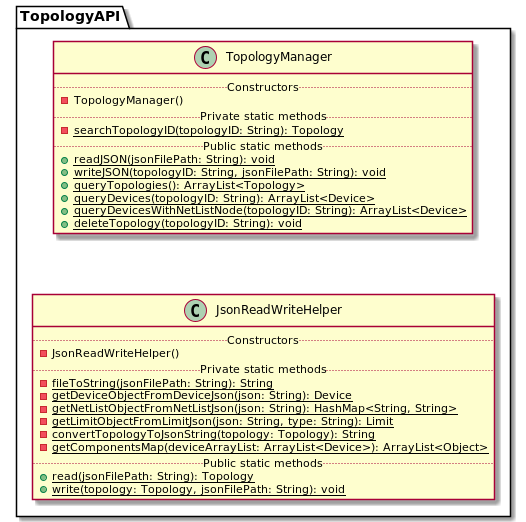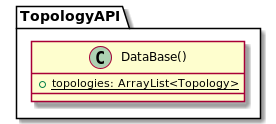Providing the functionality to access, manage and store device topologies, given different json files each includes one topology, storing them in desk and applying different queries.
- A topology is a set of electronic and electerical components that are connected together to form a device with some functionality.
- The API supports the following operations:
- Read topology from JSON file and store it in memory.
- Write topology into a JSON file and store it in disk.
- Query the list of topologies stored in memory.
- Query the components of a certain topology.
- Query the components that are conneted to each other through a given node in a certain topology.
- Delete topology from memory.
- Java is Class based, Object-Oriented Language. So it's a good choice to be used to model the API in an appropriate way.
- Java is supported by powerful Serialization and Deserialization JSON parsers like GSON, Jackson and JSON.simple.
- IntelliJ as an IDE.
- Maven as a building tool.
- Gson to parse JSON files.
- Junit5 to perform unit tests.
- Qodana, the built-in code analysis tool for IntelliJ.
TopologyAPI is modeled by three classes as follows:
- TopologyManager Class: Provides the user with the main functionality to manipulate the topologies through its methods.
- JsonReadWriteHelper Class: Provides
TopologyManagerwith helper methods to manipulate JSON files, its visibility modifier isdefaultas it's only needed byToplogyManagerto handle JSON files. - DataBase Class: Represents the memory source that the
TopologyManageruses to store the read topologies, its visibilty modifier isdefaultto make it visible only for the classes in TopologyAPI package, so it's granteed that the user of this package cannot access it.
Notes: If the API supports access to database, DataBase may contain the methods used to store, retrieve and manipulate topologies from database.
The UML Diagram of TopologyManager and JsonReadWriteHelper Class:
The UML Diagram of DataBase Class:
readJSON(String jsonFilePath):
- Description: read topology from the given JSON file.
- Parameters:
jsonFilePath: the path of the given JSON file.
- Return:
void. - Throw:
IOExceptionif the path is wrong or no such a file in this path.
writeJSON(String topologyID, String filePath):
- Description: writes the given topology in a JSON file.
- Parameters:
topologyID: the ID of the topology that wanted to be written into disk as a JSON file.filePath: the path of the file that the topology will be written into.
- Return:
void. - Throw:
IOExceptionif the path is in wrong.TopologyIDNotFoundExceptionif there's no topology with the given ID in memory.
queryTopologies():
- Description: gives the user a copy of the list of topologies currently stored in memory.
- Parameters:
void. - Return:
ArrayList<Topology>.
queryDevices(String topologyID):
- Description: gives the user a copy of the list of the components of the given device.
- Parameters:
topologyID: the ID of the topology to query its components.
- Return:
ArrayList<Device>. - Throw:
TopologyIDNotFoundExceptionif there's no topology with the given ID in memory.
queryDevicesWithNetListNode(String topologyID, String node):
- Description: gives the user a copy of the list of components that are conneted to the given node.
- Parameters:
topologyID: the ID of the topology.node: the given node to query components connected to it.
- Return:
ArrayList<Device>. - Throw:
TopologyIDNotFoundExceptionif there's no topology with the given ID in memory.
deleteTopology(String topologyID):
- Description: delete the given topology from the memory.
- Parameters:
topologyID: the ID of the topology that will be deleted.
- Return:
void. - Throw:
TopologyIDNotFoundExceptionif there's no topology with the given ID in memory.
The topologies stored in memory is modeled with the following classes:
- Topology Class: It models the topology as an ID and an array of devices, each element in this array is of type
Device. - Device Class: It models the device as an ID, type, characteristics and net list.
- Limit Class: It models the characteristics of each device as a default, minimum, maximum value of (resistance, voltage, etc...).
- TopologyIDNotFoundException Class: Defines a user-defined-exception to be thrown if the user tried to manipulate a topology in memory while it's not actually stored yet.
The UML Diagram of Topology, Device, and Limit Class:

Note: The UML Diagram of these classes shows the composition relation between them.
- Install the Used Technologies.
- Import
TopologyAPIpackage in your program, ex:
import TopologyAPI.*;
- Use the methods provided in
TopologyManageraccording to the TopologyManager Documentation.


